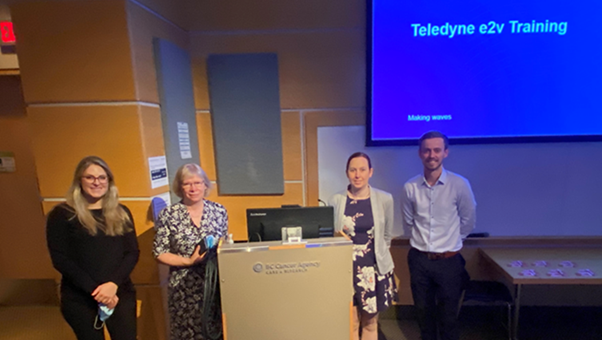By sharing expertise in the form of insights and training, Teledyne e2v and RSA are proactively supporting radiotherapy’s service engineer recruitment challenge in North America – and beyond.
A shortage of service engineers is putting the radiotherapy industry under great strain. Service engineers are vital for the maintenance of linear accelerator (LINAC) systems, and a deficit threatens to impact the delivery of consistent cancer care.
The problem is twofold. Since there is no formal schooling or certification for the job, not many people know that radiotherapy engineering can be a career. Therefore, recruiting new candidates into the field is done by existing engineers who convince friends or former colleagues to give it a try. The next issue is that training is slow and done on the job, with specialized knowledge of radio frequency (RF) power being passed down from engineer to engineer.
As a result, fewer and fewer engineers are entering the industry – and those that do join can find themselves in apprenticeships that might last 10 years before they are able to work autonomously.
It’s a global issue, but in North America the engineer workforce is ageing fast, with 50% in Canada alone set to retire at the end of 2023, according to a director who oversees radiotherapy engineers in British Columbia. Without urgent action these engineers will take their vital knowledge with them – and leave the next generation of engineers ill-prepared for the job.
Support is coming from unexpected places. Teledyne e2v is working with partners such as RSA, a leading independent service provider in the US, to offer training on its products and bring the latest research on LINAC components to engineers. But this is only the beginning: stakeholders across the industry are collaborating to formalize a learning and development curriculum that will standardize training and certification for the profession.
Temporary fixes make the crisis worse
The impact of the recruitment challenge is felt most keenly by existing engineers and cancer care teams. In response to the dwindling number of engineers, some service providers are simply assigning more machines to each engineer. This stretches resources to the limit, exacerbating the situation and leaving engineers with even less time to train new recruits.
In this situation, machines can also fall into disrepair because engineers, stretched thin, don’t have enough time to perform preventative maintenance, which can lead to machines breaking down more frequently and cause interruptions in carefully designed patient treatment plans.
Stepping up to the challenge

Facing such human costs, it’s clear that the industry needs to take a new approach.
Recruitment efforts will remain ineffective without training reforms that enable recruits to become fully-fledged engineers in a much shorter period of time. Lengthy apprenticeships simply aren’t viable when older engineers are on the brink of retirement and dealing with heavy workloads.
As the manufacturer of critical components and sub-systems for LINAC machines, Teledyne e2v understands that it has a role to play in supporting the recruitment challenge to help support the global radiotherapy industry.
Teledyne e2v has run webinars for service engineers, and, alongside RSA, in June led interactive training seminars in Toronto and Vancouver for both in-person and virtual attendees.
At these sessions, engineers were able to ask questions about Teledyne e2v products and learn how to troubleshoot problems they’ve faced in the field. Teledyne e2v has also collaborated with RSA on educational materials, such as troubleshooting guides for their components.
“It’s rare to have a manufacturer so invested in the education of the end user,” explains Ariel Kocourek, Vice President of Business Development at RSA. “Typically, training from manufacturers is limited. But Teledyne e2v brings valuable knowledge to the industry, and in turn, they receive feedback about their parts’ performance, which allows them to continually improve their products.”
A foundation for the future
Training offered by Teledyne e2v and RSA is an important step towards bringing better education to the radiotherapy service engineer community.
However, the radiotherapy industry has identified the need for a longer-term change. “Even the vendors with training programs are having difficulty attracting talent to fill their vacancies,” explains Daniel Stinson, Group Manager, Clinical Engineering, BJC HealthCare/Clinical Asset Management, St Louis, MO.
To attract the best talent and demonstrate the important role that the service engineer plays within the care team, the industry needs to offer recruits a clear development and career path. “On the surface, it may not be as appealing as some engineering fields,” states Stinson. “But the career is gratifying, and you are doing good work to help others through the worst time in their lives.”
We are seeing a shift within the global radiotherapy community towards working together on a solution. The Radiotherapy Service Engineers Association (RSEA), the global independent body for engineers, is the central point for efforts to develop a formal training and certification program – a program that will set the foundation for professional and technical knowledge in the field.
Teledyne e2v is a sponsor of the RSEA and has pledged to contribute technical training modules that will serve as continuing education credits for the certification.
By championing and investing in the creation of a formal training for radiotherapy service engineers, the industry will provide a viable career, preventing future engineer shortages, improving LINAC maintenance, and, vitally, safeguarding effective cancer care.
